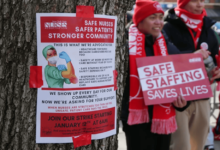The health visitor role was debated as the nursing register grew in 1924

The growth of the registered nursing workforce was one of the main topics of interest to Nursing Times for its 1 March 1924 issue.
It reported that the state register for England and Wales, which had been opened on 30 September 1921, was nearly twice as large as the year before and had reached 10,000 names.
The register was set to “grow bigger and bigger”, it noted, and would soon rival the medical directory of doctors in size. For context, there are now well over 700,000 nurses listed on the Nursing and Midwifery Council register.
In addition, Nursing Times reported that the Irish General Nursing Council had begun work and there were 3,331 nurses on its register; this figure is now nearer 85,000.
More column inches were dedicated, however, to a discussion on whether the role of health visitor should be combined with nursing, in particular district nursing. A report covered a debate on the matter held by the Newcastle branch of the College of Nursing.
Those in favour of the controversial move noted that both basic and supplementary training was very similar at the time for health visitors and district nurses, and there was an ethical argument for a health visitor to provide nursing care when it was needed.
With some emotion, the article stated: “Visualise a working mother’s home, her baby desperately ill with broncho-pneumonia. The health visitor comes in to health-visit (ie advise, supervise), and after expressing regret and talking some, she leaves. Do you mean to tell me that nurse does not feel ill at ease and unhappy.”
Those in favour also felt that one health professional should, during the same visit, be able to tackle the ailments of babies, toddlers, expectant and nursing mothers, rather than splitting it between two separate clinicians. “There is duplication and overlapping in the home; to this extent there is waste of time travelling; and all health visitors in rural areas know the weariness of it,” noted Nursing Times. However, those against the idea, highlighted that, while all health visitors would be trained nurses, not all nurses were potential health visitors. One hundred years later, the status quo remains.
Articles of a more clinical nature focused on the treatment of haemorrhoids and the hygiene of the skin, specifically the internal cause of greasy skin. Another piece described the oxygen chamber at Guy’s Hospital. It had been created to treat soldiers involved in gas attacks during the First World War and, according to researchers, subsequently appeared beneficial for patients with pneumonia.
There was good news for midwives. “Certified midwives have long wished for a badge and their cry has reached the ears of the Central Midwives Board,” noted a news in brief in Nursing Times. But a short piece of legislation was needed for the board to officially issue “even such a trifle as a badge” and, therefore, midwives would need to wait a little longer for their “coveted hallmark”.
On the same page was a seemingly innocuous article on the retirement of Annie Louisa Earle, matron of the Sheffield Royal Hospital, who had resigned in order to move to Devon. A member of the Territorial Force Nursing Service, she had served during the First World War, first in Mesopotamia – modern day Iraq and parts of neighbouring countries – and then in India. While in Mesopotamia she was mentioned in despatches and awarded the Royal Red Cross and Bar. Despite her reported retirement plans, she eventually died in Sheffield on 5 June 1952. Her medals and other service decorations came up for auction in 2002 and again in 2013, when they were sold for £2,400.
On the advertising side of things, Benduble ward shoes were described as the “comfort” footwear for nurses. “If she wears Benduble shoes her feet never tire – she is always fresh – rested in body – smiling and happy,” the advert promised. A not dissimilar advert backed the drink Ovaltine for “busy and overworked nurses”. “I am never fagged-out now, thanks to Ovaltine,” said a drawing of a nurse in the advert, using the vernacular of the period.
Last but not least, the Nurses’ Supply Association advertised its early spring collection. This included the ‘Brompton’, a ready-to-wear nurse’s coat frock uniform dress, and the ‘London’, a newly designed uniform in proofed Cheviot Serge. In the world outside of Nursing Times, Annie Matheson, a British author known for writing a biography on Florence Nightingale, died on 16 March at the age of 70.
Nursing Times Archive
With Nursing Times’ online archive of its print issues, subscribers can dip into the history of nursing at the touch of a button and discover how it has changed over the decades. Each issue’s stories, features and even advertisements give a fascinating insight into the profession and much more. Representing over 100 years of nursing history, the Nursing Times Archive starts with the very first issue of the magazine, which was published on 6 May 1905. This great resource can be accessed directly from our website.
To start exploring, visit: nursingtimes.net/digital-archive







